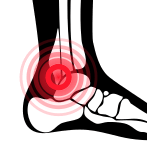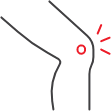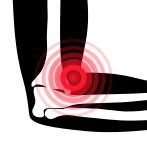The work-from-home, digital era has many of us sitting in front of our computers for more hours than we might like to admit. While the comforts of home are plenty, they’re not doing any favors for our hip health. Lots of people struggle with hip conditions; whether from an injury or you simply have tight hips, hip pain is common. But what if your hip pain is something more?
What is Hip Impingement Syndrome?
Hip impingement syndrome is a condition that results from an abnormality in the movement of the hip joint. The hip is a ball-and-socket joint. The head of the femur bone (thigh bone) acts like a ball that fits into the pelvis, which acts like a cup. Together, the two mimic a baseball fitting perfectly into a glove.
People with healthy hips have no problem with the ball smoothly gliding into the socket. Hip impingement syndrome, however, is when the ball doesn’t glide smoothly into the socket, resulting in pain.
Signs & Symptoms of Hip Impingement Syndrome
Pain is the most generalized symptom of hip impingement syndrome, but other symptoms of hip impingement syndrome include:
- Pain in the groin, especially when walking or flexing the hip
- Decreased range of motion in hip
- Increasing pain with subtle activities. For example, even things like sitting for long periods of time or walking on a small incline may start to hurt.
What Causes Hip Impingement Syndrome?
The jury’s out as far as the exact causes of hip impingement syndrome but the overall consensus is that repetitive hip flexion damages the socket cartilage. There are two main types of hip impingement syndrome:
- Cam impingement, where there is a deformity of the ball at the top of the femur. This is commonly noticed during activities like riding a bicycle or tying your shoes, where the hip is bent.
- Pincer impingement, where there is a deformity of the socket. In this case, the front rim of the socket sticks out too far and the femur bumps into the rim of the socket during regular hip flexion.
Other causes of hip impingement syndrome include:
- Legg-Calve-Perthes Disease – the hip joint does not receive enough blood flow. not enough blood flow to hip joint
- Slipped capital femoral epiphysis – the ball separates from thigh bone at the growth plate.
- Coxa vara – a condition where the thigh bone and the ball don’t grow at same pace. This leads to a deformity of the hip joint.
Some people experience hip joint abnormalities from birth while others see that they develop over time.
If you’re experiencing symptoms related to hip impingement syndrome, your physiotherapist will likely run a gamut of tests to determine if you have hip impingement syndrome. They will look at your symptoms, conduct a physical exam, and will refer you to a specialist, if needed, to run imaging tests including X-rays, MRIs, and CT scan. Imaging is not needed to diagnose hip impingement.
Treatments for Hip Impingement Syndrome
Great news! Surgery is often not the first stop for hip impingement syndrome. Instead, physical therapy is often the preferred step to recovery.
Working with a physical therapist who specializes in hips and helping people recover from hip injuries/surgeries is one of the best ways to heal. Your physical therapist will work with you to strengthen the muscles around the hip, relieve inflammation, and reduce pain.
Next Level Physio Physical Therapy for Hip Impingement Syndrome
Your hips deserve to be happy and Next Level Physio is here to make that happen. We deal with hip pain all the time, which means we know just what you need to get back on the path towards pain-free living.
What do we do differently at Next Level? On top of using cutting edge modalities and treatment strategies, we also provide you with programming to keep the rest of your body from deteriorating, and for those who are active, we can coach you on what CAN do to keep fit and healthy during the long recovery process.
Our goal is simple: help you heal without medication or surgery. In addition to physical therapy for hip impingement syndrome, we also work with patients for conditions including:
- Sports injuries
- Pre-surgical rehab
- Post-surgical rehab
- Neck pain
- Shoulder and elbow pain
- Vertigo and concussion
- Wrist and hand pain
- Ankle and foot pain
- Sciatica/back pain… and more
Some of the physical therapy methods we use for pain treatment include:
- IASTM Technique
- Blood Flow Restriction Training
- Therapeutic Exercise
- Shockwave
- Cold Laser
- Australian Manual Therapy
- Cupping, and more
Click here to schedule an appointment and a free consultation.















